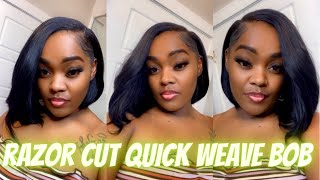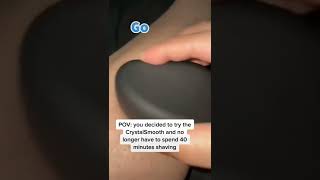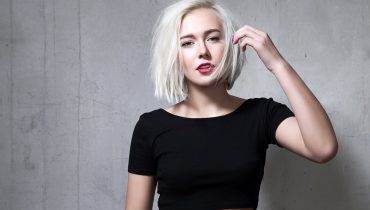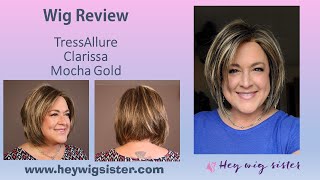How-To: Razor Cut Soft Shag
- Posted on 02 August, 2022
- Heatless Hairstyles
- By Anonymous
Guests at the salon are now embracing their natural texture & want ease of styling with movement, & it all starts with a great haircut. Similar to what is happening in fashion - movement that lives within structured lines. Guests love it because it takes minimal styling effort…yet can easily become more refined or dramatic depending on the finish.
“I hope this concept inspires stylists to appreciate new & different ways of doing things. To pause and re-think how we look to the past for inspiration to shape the future as we find new meaning in old references. I hope we can all develop contemporary theories & practices on how to better approach a lived-in precision cutting concept and how it affects all textures.” - Sam Villa
Sam Villa Tools Used:
• Signature Series Razor https://www.samvilla.com/shop/razors/s...
• Pro Ionic Light Blow Dryer https://www.samvilla.com/shop/blow-dry...
• Deep Bowl Diffuser https://www.samvilla.com/collections/h...
Full list of credits: https://bit.ly/3JvmtzC
Want more education? Make sure to subscribe: http://bit.ly/2mCNIib Click that bell on the screen to make sure notifications are on! To learn more about all of our styling tools, discover upcoming events, or to book one of our artists for events or in-salon education visit us: www.samvilla.com
Get Social with us!
Instagram - https://bit.ly/2Bq94bt
TikTok- https://bit.ly/3AdlboU
Facebook - https://bit.ly/2PKuAAi
Pinterest - https://bit.ly/2DytLDo
Linkedin - https://bit.ly/2PGdfZo
Twitter - https://bit.ly/2BnqG7Q
Lived in precision an empowering concept, hair fashion continues to be told through a visual and wearable stories. Shake up the imagination. Think past happy eras, the roaring twenties the summer of love in the 60s and the loved-up rave scene of the 80s consumers will seek out. Looks that stimulate and make proactive or confident statements rise up and rediscover the joy and design embrace the opportunity and most of all have fun. The 70s shag haircut is a haircut that has withstood the test of time. We continue to be inspired by the shape, but reinvent it. For today's looks this is the haircut we will be creating on today's model alyssa to begin this haircut, we'll start in the front, taking your comb from the outside corner of the eye and rocking it up to the head, shape you'll find the change in direction of Where the hair moves forward towards the face create your fringe section on either side of the head and isolate it by gently twisting the hair next take a line of sectioning from the front to the apex to the back of the head to separate the right from The left using a sam via tail comb, you will next create a zigzag section in the parietal ridge area. The depth of this zigzag will depend on the client's density. If your client has high density or a lot of hair, the zigzag will be deeper. You can also move the zigzag line lower in the head shape. If your client has low density hair, then you would want the zigzag to be higher with a smaller zigzag pattern to retain more depth and density below this line. Once you've established the sections clip them off with your samvia sectioning clips, as you continue this section around to the other side of the head. Think about where do the zigzags live in this head shape in relation to the density? That'S below it as you come to the front of the ear. There'S not much hair below that zigzag, be thoughtful about where the peaks and valleys live in your zigzag to retain that length. Coming back to the front of your fringe section, take a smaller interior triangle! Section split that in half on one side elevate to horizontal 90 degrees and then over direct to the opposite side from where it lives, with your samvia razor use. Small strokes to gently add softness into this cut repeat on the other side. Utilizing over direction helps to create soft length as it gains away from the face. This is a simple way to create a curtain fringe with consistency and balance. Once you've completed the interior triangle, you will then continue through the extension of the fringe area. The same principles apply elevation at horizontal 90 degrees over direct to the opposite side. Simply use your guide underneath from your previously cut section, continue to use small strokes with your razor to create softness in this look notice, as ellen uses, her razor she's, varying where the razor is working in the hair, slightly shifting it on top and then back to The sides this adds an increased softness in this section when the razor is on top. It'S cutting out more length when the razor hits the side it's creating more texture. Let'S move to the sides from the section from in front of the ear over direct towards the front of the face, then elevate, the hair to about 45 degrees above a horizontal 90 line, using the guide from your fringe area cut from the top to the bottom Of the section, slightly sliding your hand out to retain length in the perimeter as we work with a razor and, through this shape, a lot of these decisions are based on your visual connection, with what you want. Your end result to be once you've cut, let it fall back into place and see if this is the length that you and your client have agreed to, if it needs to be adjusted, be sure to go back into the same elevation and over direction that you Had previously repeat the same steps on the opposite side, remember one great way to retain the consistency in your elevation is to turn your client to a profile to the mirror, use the mirror to ensure that you are repeatedly elevating to the same point with each section. Now we can move to the back working in a center back section elevate, the hair to 45 degrees above the horizontal 90. working with your razor use, long strokes to create a short interior. But let your hands slide through this section to retain length notice. The blade is connecting with the top of the section and working consistently and smoothly with the movement now moving from center back towards the ear each section will be elevated and now over directed to center back the same razor stroke and movement will keep consistency in the Graduation, when working with the razor many times we're connecting with visual guides versus physical guides, meaning we keep an eye on where the previous section was visually, rather than always connect it to our hands physically. This is how we get perfection with imperfection within our shapes. Now we'll move to the top of the head shape, starting again in center back taking a vertical section and elevating straight up at the top point of that section, we'll establish a guide notice. How ellen is softly moving the razor in an upward motion to continue with the feathery feeling of this shape? Now, taking the vertical section elevating straight up, you have a guide for the short interior with a razor we cut from short to long using the guide from the high point of the head. The blade of the razor will point up towards the ceiling use longer strokes. Coming from your elbow for consistency in your cut as you work with this section, keep in mind, the top is disconnected from the bottom to check the balance. Let the length fall on top of the underneath section to see if it marries together cohesively with the disconnection that will help. You find the longest length in this section from the high point of the head towards the back of the head. Once you've established the desired length, continue with your razor through that section to create a seamless blend between the two disconnected sections drop. The base of your last cut section to ensure the length matches consistently use your razor for any type of visual connection. You need you'll continue to work through the back of the head in this top section, repeating the steps that you did in the first, depending on the client's density will determine how thick or how thin of a section you can take. When we combine multiple sections together, we call these compressed these work perfectly with a tool like a razor, because we're creating perfect imperfection with this tool, compressed sections make quick work to get to our end result notice. The long strokes that ellen is using with her razor. This is the magic of what creates the 70s inspired shag. It will open up and encourage any natural texture in alyssa's hair. Moving to the front simply take the section on either side elevate straight up to vertical 90 degrees and cut the length. This length will go short to long with the length moving towards the front of the head to encourage texture, for this shape, apply. Redken'S full frame 0-7 volumizing mousse ensure that the hair is fully saturated. Now, using a bowl, diffuser gently work, the hair up and begin to dry. The more you manipulate this shape with your hands as it dries the fuzzier. The hair will be stabilize your hand and stabilize the diffuser as you use it, to create consistent, strong curl, and here we have the alyssa shag. Look at the movement. This has been created with the razor and disconnection. What a beautiful way to create lived in style that shows off your clients, best natural texture, partnering with the right tools and techniques. This classic shag has been modernized for today's world. You





Comments
anthony falcone: This was a great tutorial. So easy to understand,and your voice is so soft and soothing. Thank you!
David Campbell: I absolutely loved seeing a different perspective on cutting a Shag haircut. Brilliant!
A & R Creative Creations: Every time I get a razor cut I end up getting split ends, how do I stop that?
Caramanchel TA: Lovely! I just want to have an appointment with such a hair stylist! How can I go about it?
Lolita CB: Do you change the blade for each haircut?
Alessia Corr: